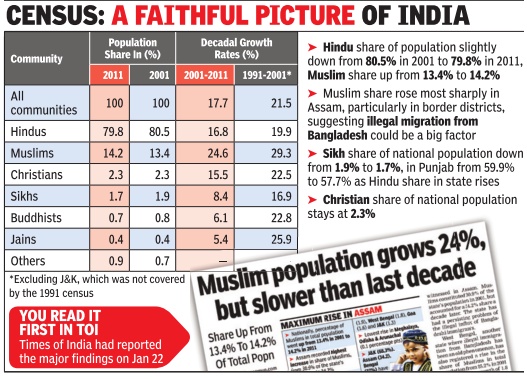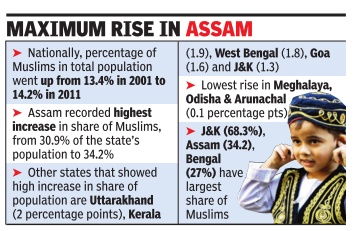Muslims: India (after 1947)
This is a collection of articles archived for the excellence of their content. |
Contents |
2011
2011: 14.2% of Indians are Muslim
Muslim population grows 24%, but slower than last decade
Bharti Jain The Times of India
Share Up From 13.4% To 14.2% Of Total Popn
The 2011 census data on the population of religious groups shows a 24% rise in the Muslim population between 2001 and 2011, with the community's share of India's total population rising from 13.4% to 14.2% over the 10-year period.
While the growth rate of the Muslim population has slowed from the figure of around 29% recorded between 1991 and 2001, it is still higher than the national av erage of 18% for the decade.
The data accessed by TOI shows that the most rapid rise in the share of Muslims in the total population was witnessed in Assam. Muslims constituted 30.9% of the state's population in 2001, but accounted for a 34.2% share a decade later. The state has had a persisting problem of the illegal influx of Bangladeshi immigrants.
West Bengal, another state where illegal immigration from Bangladesh has been an old phenomenon, has also registered a rise in the share of Muslims in total population from 25.2% in 2001 to 27% in 2011, a growth of 1.8 percentage points over the 10 years, more than double the national average. Uttarakhand reported a sharp rise in the share of Muslim population from 11.9% to 13.9%, a growth of 2 percentage points against the countrywide growth of 0.8 percentage points between 2001 and 2011.
Other states with a significant rise in the share of Muslims in the total population as per the 2011 census were Kerala (from 24.7% to 26.6%), Goa (6.8% to 8.4%), Jammu & Kashmir (67% to 68.3%), Haryana (5.8% to 7%) and Delhi (11.7% to 12.9%).
The census office had compiled this data by March last year, but the UPA government held back the release, perhaps fearing political repercussions of the findings on the eve of Lok Sabha elections. Union home minister Rajnath Singh last week gave his go-ahead when Registrar General of India and Census Commissioner C Chandramouli asked whether the “sensitiive“ figures should be released.
Singh on Wednesday confirmed that the data would be made public soon.
Interestingly , Manipur was the only state to show a fall in Muslim population as a percentage of its total population (a fall of 0.4 percentage points).
The high growth of Muslim population in Assam has been intensely debated and has been a source of political confrontation. In fact, a re port prepared on the issue in 1998 by the then governor of Assam, Lt Gen (Retd) S K Sinha, had warned that illegal immigration was slowly changing the demographic profile in several districts.The Supreme Court has on more than one occasion expressed concern over the change in demography and chided the government for not stopping infiltration from Bangladesh.
2011: Rise in Muslim population
The Times of India, Aug 26 2015

Census: Kerala, U'khand saw rise in Muslim population
The share of Hindus in India's population came down a tad from 80.5% in 2001 to 79.8% in 2011, while the share of Muslims rose from 13.4% to 14.2%, Census data released on Tuesday showed.Among the other large religious communities, Christians remained at 2.3% of the population and the Jains at 0.4%, while Sikhs dropped slightly from 1.9% to 1.7% and Buddhists from 0.8% to 0.7%, the data showed. The official release confirmed what TOI had reported a good seven months earlier, on January 22. The Census has had the data ready for over a year, but had not made it public. Coming as it does in the build-up to the assembly elections in Bihar, the data could stir up even greater heat and passion than it would normally .
In line with the overall decline in the decadal growth rate of the country's population, all religious communities have seen the growth rates of their populations de DIVINE NUMBERS: P 24 clining sharply in the 20012011 period, compared to the rates in the earlier decade.The lowest decline was recorded among Hindus, from 19.9% to 16.8%.
While the national shares of different religious groups have changed only marginally, the changes are somewhat more sizeable in states like Assam, West Bengal, Kerala, Punjab, Uttarakhand and some states in the northeast.
In Assam, for instance, the share of Muslims in the total population has increased from 30.9% in 2001 to 34.2% in 2011. That illegal migration from Bangladesh is playing a part in this is evident from the fact that nine of the state's 27 districts are now Muslim-majority compared to six of 23 earlier. All of these districts are in the areas bordering Bangladesh.
In West Bengal too, the Muslims in 2011 constituted 27% of the population against 25.2% a decade earlier, though in this case the border districts do not show a no ticeable jump in minority population shares compared to 2001. Uttar Dinajpur has joined Malda and Murshidabad in the list of districts where Muslims outnumber Hindus, though at 49.9% they are just short of being an outright majority . Kerala and Uttarakhand have also registered significant increases in the share of the Muslims in their population, while in many other states there is a small increase in the share of Muslims.
In Punjab, on the other hand, the share of Hindus has increased from 36.9% to 38.5%, with the share of Sikhs dropping from 59.9% to 57.7%. The Sikhs have also declined from 16.1% to 13.1% of Chandigarh's population and from 4.0% to 3.4% of Delhi. The Hindu share of population has also risen by one percentage point in Nagaland, and more marginally in Karnataka and Goa and in some of the union territories like.
In Arunachal Pradesh and Manipur, the Christians formed a significantly larger share of the population in 2011 than they did in 2001. In Arunachal, their share rose from 18.7% to 30.3%, while in Manipur it rose from 34% to 41.3%, which is just a little lower than the 41.4% share of population that Hindus have in the state.
Muslims can not be SC
Muslims not entitled to SC status, says HC
The Punjab and Haryana high court on Tuesday ruled Muslims were not entitled to benefits reserved for the Scheduled Castes (SC) while cancelling the 2012 election of Congress MLA Mohammad Sadiq from Punjab's reserved Bhadaur constituency.
Justice N K Sanghi said Sadiq was not qualified to contest from the SC reserved seat as he is a Muslim and had failed to prove he had converted to Sikhism.
Sadiq had claimed before the court he was an SC Muslim before he had converted to Sikhism. He had pleaded he should be considered SC Sikh after his conversion.
The high court order came on the petition of ex-IAS officer and ruling Shiromani Akali Dal's Darbara Singh Guru, who had lost the election to Sadiq by nearly 7,000 votes.
"...the court has found that since he is a Muslim, he cannot get benefits of SCs. The reverse has also been clarified thorough this case," said Guru's lawyer, Satya Pal Jain.
Jain said this is the first judicial pronouncement on who can be considered an SC. "The Constitution (Scheduled Castes) Order, 1950, states that only Hindus, Sikhs and Buddhists can avail benefits as SCs. This is because the caste system is prevalent only in these religions."
Sadiq had told the court his mother, Prasanni Devi, was a Muslim who never followed Islam and that he had "always professed Sikhism and was an SC".
He claimed he belonged to the Doom community, which the Punjab government had notified as SC.
Sadiq, a well-known Punjabi folk singer, claimed he had converted to Sikhism in 2007, but Jain contested this stating he had not follow the prescribed procedure, including notifying the Shiromani Gurdwara Prabandhak Committee.
Guru, a former principal secretary to chief minister Parkash Singh Badal, had accused Sadiq of misleading the Election Commission. He contended Sadiq was still a Muslim.
Guru had filed his petition on March 30, 2012 and the high court had reserved its judgment in January. Barnala-resident Badal Singh had earlier moved the Punjab Scheduled Caste Commission before the assembly polls demanding cancellation of Sadiq's SC certificate that Ludhiana administration had issued in 2006.
Flowers for dieties farmed by Muslims: Kerala
The Times of India, Jun 07 2015
Tp Nijeesh
Malappuram
Flowers for Kerala deities bloom in Muslim farms
It is known to very few devotees that the lotus blooms used in all major temples across the state including Guruvayur Sri Krishna Temple, Sabarimala, Kodungalloor Bhagavathy Temple, Paramekkavu Bhagavathi Temple, Thriprayar Sri Rama Temple and Parshinikkaadavu Muthappan Temple are all farmed by Muslim families.
On an average, the village collects and distributes around 20,000 blooms every day. “Our business has thrived only because of the blessings of the deities and the revenue from temples,“ says a supplier flowers to Guruvayur and Paramekkavu temple in Thrissur from his 85-acre farm.
The flowers are handed over to members of the War rier community , who handle floral decorations in temples.“The Muslim families of Thirunavaya have maintained a good relationship with all temples,“ says Unni Varrier of Kadambuzha Bhagavathy Temple Devaswom.
But lotus farming is becoming increasingly difficult for farmers. “Water hyacinths pose a major issue. Also, water levels have been receding over the years. Sometimes it is difficult to continue farming, especially with nil government aid,“ he says.
See also
Muslims in central India: 1916 <>
…and countless other articles about Muslim communities by clicking the Communities link below or by entering a word or phrase in the Search rectangle on the top right of this page.

